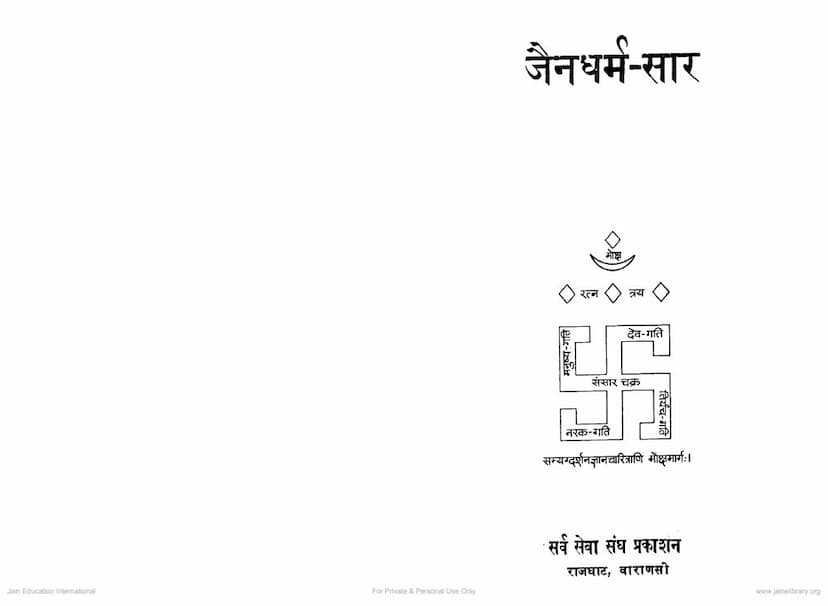Jain Dharma Sar
Added to library: September 2, 2025
Loading image...

Summary
This Jain text, titled "Jain Dharma Sar" (Essence of Jain Dharma), published by Sarva Seva Sangh Prakashan, is a compilation of essential Jain teachings. The book aims to present the core principles of Jainism in a concise and accessible manner, suitable for both Jain and non-Jain readers.
Key themes and concepts covered in the text include:
- Ratna Traya (The Three Jewels): The foundational principles of Samyak Darshan (Right Faith/Perception), Samyak Gyan (Right Knowledge), and Samyak Charitra (Right Conduct) are presented as the path to liberation (Moksha).
- Samsara Chakra (The Cycle of Birth and Death): The text describes the cyclical nature of existence, including the realms of rebirth such as the hellish realms (Naraka-gati).
- The Publisher's Note (Nivedan): The publisher emphasizes the need for inter-religious understanding and harmony in the modern world. The goal of this book is to distill the essence of Jain scriptures, similar to how they have done for other religious texts like the Bhagavad Gita and Dhammapada. The initial publication is intended for scholarly review and feedback before a final version is released. The ultimate aim is to provide a universally understandable summary of Jainism.
- Vinoba Bhave's Vision: The text highlights Vinoba Bhave's encouragement for the creation of such a book, drawing parallels between the Dhammapada for Buddhism and the desire for a similar authoritative collection of Mahavir's teachings. He believes a well-researched compilation would be more impactful than numerous individual books on Jain thought.
- Structure and Content of the Book:
- The book contains a collection of 429 gathas (verses) and shlokas (stanzas) from ancient Jain scriptures and commentaries, with no added words from the compiler except for clarification in brackets or footnotes.
- It covers nearly all fundamental aspects of Jain philosophy, including the concepts of Jiva (soul) and Ajiva (non-soul), the causes of bondage (Asrava, Bandha), the path to liberation (Samvara, Nirjara), and the ultimate goal of Moksha.
- The selection is drawn equally from Shvetambara and Digambara literature, with cross-references to enable readers to see the agreement between the two traditions on most philosophical and religious matters. Minor practical differences are noted in the final section.
- Efforts were made to use Prakrit verses, but Sanskrit verses were included where suitable Prakrit verses were unavailable to maintain the flow of topics.
- Core Jain Philosophy:
- Jainism is presented as a philosophy that emerged from the broader Shramanic tradition, considered eternal and unborn. Lord Mahavir is seen as one of many great souls who have appeared throughout time.
- The text explains the Jain concept of the soul (Jiva) as the conscious entity within every being, distinct from the physical world (Pudgala).
- The ultimate aim is the attainment of "Truth" (Satya), which transcends sectarian labels.
- The philosophy is described as having a unique perspective (Svadhyaya) that allows for the assimilation of all other philosophical and religious views without negation.
- The concept of Syadvaada (the doctrine of manifold aspects) is highlighted as a key principle that allows Jainism to embrace diverse viewpoints.
- The nine fundamental principles (Navatattva) are explained: Jiva (soul), Ajiva (non-soul), Asrava (influx of karma), Bandha (bondage), Punya (meritorious karma), Papa (demeritorious karma), Samvara (cessation of karma influx), Nirjara (shedding of karma), and Moksha (liberation).
- Dharma is defined as the inherent nature of the soul, which is equanimity and freedom from attachment and aversion. The path to realizing this nature involves both right knowledge (Gyan) and right conduct (Charitra), guided by right faith (Darshan).
- The text emphasizes the importance of Anekanta (non-absolutism) and Syadvaada in understanding reality, stating that any attempt to negate other viewpoints is a grave error.
The book aims to provide a comprehensive and balanced overview of Jainism, making its profound philosophical insights accessible to a wider audience.